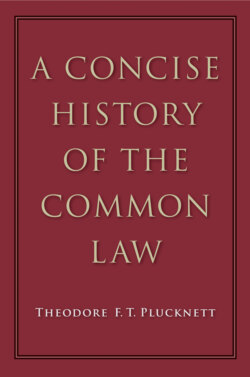Читать книгу A Concise History of the Common Law - Theodore F. T. Plucknett - Страница 130
На сайте Литреса книга снята с продажи.
THE TRAVELLING COURT: JUSTICES IN EYRE
ОглавлениеIt was a feature of mediaeval life that the King and his court were constantly travelling through the length and breadth of the kingdom, and that in the course of these journeys a general supervision would be effected over the conduct of royal officers, the working of local institutions, the collection of revenue and the redress of grievances. It was only natural that the idea should be extended, and that kings should send out some trusted officer to conduct similar progresses through the country for the same general purposes. Charlemagne in the early ninth century had developed a regular system of such missi dominici,1 and very soon after the Conquest, as we have already seen,2 a similar device is found in England. At the head of this travelling group of officials were the Justiciars—and it must be remembered that their title does not imply that their duties were primarily judicial, but merely that they were the direct personal representatives of the King.3 The King’s Court was thus enabled to be in several places at once; besides the principal body, which was always in the presence of the King himself, there might be several groups of officials touring the country as Justices in Eyre, as they soon came to be called. In this way the custom and practice of the King’s Court was made more familiar by being spread over the country, and by being brought into contact with local institutions. During the reign of Henry II these Eyres are very frequent, and Bracton and his successors treat them as a separate judicial jurisdiction.1 The experiment was so successful that Philip Augustus soon set up a similar system in France.2 There can be no doubt that there was much important legislation effected (which is now largely lost) by means of instructions to the justices as they set out upon their Eyre.
Their jurisdiction varied; in the early years of Henry III they might be commissioned “ad omnia placita”, and then their impressive “general eyre” (as Maitland called it3) became in effect the court of common pleas on circuit, instead of at Westminster. These justices with their “roll of secrets” and their “book of death”4 undoubtedly struck terror into the country,5 but as their organisation became more refined they became more and more an engine of oppression. Technical errors in legal and administrative procedure, slight inaccuracies in matters of detail were made the excuse for fines upon the whole vill or county. In the thirteenth century Eyres were frequent6 and the financial yield considerable: in 1227 a judge reckoned a profit of 40 marks a day for the king, and in 1301 Edward I “caused justice to be done on malefactors” in order to recoup the expenses of twenty years of war, and thereby “amassed great treasure”.7 In the early fourteenth century we have a full report of an Eyre which visited Kent in 1313 from which every detail of its work can be traced.8 Already protests against general Eyres appear in Parliament and after the middle of the century Eyres ceased to be commissioned. For a time it seemed as if the new device of constant tours by the King’s Bench from the middle of the fourteenth century onwards might serve the same purposes as an eyre,9 but in the end it was seen that they were in fact no longer necessary, for (as we shall see in the next chapter) newer means were being developed which put local institutions under an even more effective control, while the rise of parliamentary taxation provided a more satisfactory source of revenue.
